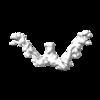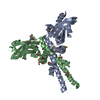[English] 日本語
 Yorodumi
Yorodumi- EMDB-23512: XLF, XRCC4 and LigIV C-BRCT in the NHEJ Long-range synaptic complex -
+ Open data
Open data
- Basic information
Basic information
| Entry | Database: EMDB / ID: EMD-23512 | |||||||||||||||||||||
|---|---|---|---|---|---|---|---|---|---|---|---|---|---|---|---|---|---|---|---|---|---|---|
| Title | XLF, XRCC4 and LigIV C-BRCT in the NHEJ Long-range synaptic complex | |||||||||||||||||||||
 Map data Map data | XLF-XRCC4-LigIV C-BRCT in the Long-range synaptic complex in NHEJ | |||||||||||||||||||||
 Sample Sample |
| |||||||||||||||||||||
| Biological species |  Homo sapiens (human) Homo sapiens (human) | |||||||||||||||||||||
| Method | single particle reconstruction / cryo EM / Resolution: 9.3 Å | |||||||||||||||||||||
 Authors Authors | He Y / Chen S | |||||||||||||||||||||
| Funding support |  United States, 6 items United States, 6 items
| |||||||||||||||||||||
 Citation Citation |  Journal: Nature / Year: 2021 Journal: Nature / Year: 2021Title: Structural basis of long-range to short-range synaptic transition in NHEJ. Authors: Siyu Chen / Linda Lee / Tasmin Naila / Susan Fishbain / Annie Wang / Alan E Tomkinson / Susan P Lees-Miller / Yuan He /   Abstract: DNA double-strand breaks (DSBs) are a highly cytotoxic form of DNA damage and the incorrect repair of DSBs is linked to carcinogenesis. The conserved error-prone non-homologous end joining (NHEJ) ...DNA double-strand breaks (DSBs) are a highly cytotoxic form of DNA damage and the incorrect repair of DSBs is linked to carcinogenesis. The conserved error-prone non-homologous end joining (NHEJ) pathway has a key role in determining the effects of DSB-inducing agents that are used to treat cancer as well as the generation of the diversity in antibodies and T cell receptors. Here we applied single-particle cryo-electron microscopy to visualize two key DNA-protein complexes that are formed by human NHEJ factors. The Ku70/80 heterodimer (Ku), the catalytic subunit of the DNA-dependent protein kinase (DNA-PKcs), DNA ligase IV (LigIV), XRCC4 and XLF form a long-range synaptic complex, in which the DNA ends are held approximately 115 Å apart. Two DNA end-bound subcomplexes comprising Ku and DNA-PKcs are linked by interactions between the DNA-PKcs subunits and a scaffold comprising LigIV, XRCC4, XLF, XRCC4 and LigIV. The relative orientation of the DNA-PKcs molecules suggests a mechanism for autophosphorylation in trans, which leads to the dissociation of DNA-PKcs and the transition into the short-range synaptic complex. Within this complex, the Ku-bound DNA ends are aligned for processing and ligation by the XLF-anchored scaffold, and a single catalytic domain of LigIV is stably associated with a nick between the two Ku molecules, which suggests that the joining of both strands of a DSB involves both LigIV molecules. | |||||||||||||||||||||
| History |
|
- Structure visualization
Structure visualization
| Movie |
 Movie viewer Movie viewer |
|---|---|
| Structure viewer | EM map:  SurfView SurfView Molmil Molmil Jmol/JSmol Jmol/JSmol |
| Supplemental images |
- Downloads & links
Downloads & links
-EMDB archive
| Map data |  emd_23512.map.gz emd_23512.map.gz | 33.9 MB |  EMDB map data format EMDB map data format | |
|---|---|---|---|---|
| Header (meta data) |  emd-23512-v30.xml emd-23512-v30.xml emd-23512.xml emd-23512.xml | 19.3 KB 19.3 KB | Display Display |  EMDB header EMDB header |
| FSC (resolution estimation) |  emd_23512_fsc.xml emd_23512_fsc.xml | 7.8 KB | Display |  FSC data file FSC data file |
| Images |  emd_23512.png emd_23512.png | 37.4 KB | ||
| Archive directory |  http://ftp.pdbj.org/pub/emdb/structures/EMD-23512 http://ftp.pdbj.org/pub/emdb/structures/EMD-23512 ftp://ftp.pdbj.org/pub/emdb/structures/EMD-23512 ftp://ftp.pdbj.org/pub/emdb/structures/EMD-23512 | HTTPS FTP |
-Validation report
| Summary document |  emd_23512_validation.pdf.gz emd_23512_validation.pdf.gz | 302.9 KB | Display |  EMDB validaton report EMDB validaton report |
|---|---|---|---|---|
| Full document |  emd_23512_full_validation.pdf.gz emd_23512_full_validation.pdf.gz | 302.4 KB | Display | |
| Data in XML |  emd_23512_validation.xml.gz emd_23512_validation.xml.gz | 9.8 KB | Display | |
| Arichive directory |  https://ftp.pdbj.org/pub/emdb/validation_reports/EMD-23512 https://ftp.pdbj.org/pub/emdb/validation_reports/EMD-23512 ftp://ftp.pdbj.org/pub/emdb/validation_reports/EMD-23512 ftp://ftp.pdbj.org/pub/emdb/validation_reports/EMD-23512 | HTTPS FTP |
-Related structure data
- Links
Links
| EMDB pages |  EMDB (EBI/PDBe) / EMDB (EBI/PDBe) /  EMDataResource EMDataResource |
|---|
- Map
Map
| File |  Download / File: emd_23512.map.gz / Format: CCP4 / Size: 38.4 MB / Type: IMAGE STORED AS FLOATING POINT NUMBER (4 BYTES) Download / File: emd_23512.map.gz / Format: CCP4 / Size: 38.4 MB / Type: IMAGE STORED AS FLOATING POINT NUMBER (4 BYTES) | ||||||||||||||||||||||||||||||||||||||||||||||||||||||||||||||||||||
|---|---|---|---|---|---|---|---|---|---|---|---|---|---|---|---|---|---|---|---|---|---|---|---|---|---|---|---|---|---|---|---|---|---|---|---|---|---|---|---|---|---|---|---|---|---|---|---|---|---|---|---|---|---|---|---|---|---|---|---|---|---|---|---|---|---|---|---|---|---|
| Annotation | XLF-XRCC4-LigIV C-BRCT in the Long-range synaptic complex in NHEJ | ||||||||||||||||||||||||||||||||||||||||||||||||||||||||||||||||||||
| Projections & slices | Image control
Images are generated by Spider. | ||||||||||||||||||||||||||||||||||||||||||||||||||||||||||||||||||||
| Voxel size | X=Y=Z: 2.2 Å | ||||||||||||||||||||||||||||||||||||||||||||||||||||||||||||||||||||
| Density |
| ||||||||||||||||||||||||||||||||||||||||||||||||||||||||||||||||||||
| Symmetry | Space group: 1 | ||||||||||||||||||||||||||||||||||||||||||||||||||||||||||||||||||||
| Details | EMDB XML:
CCP4 map header:
| ||||||||||||||||||||||||||||||||||||||||||||||||||||||||||||||||||||
-Supplemental data
- Sample components
Sample components
-Entire : XLF, XRCC4 and LigIV C-BRCT in the NHEJ Long-range synaptic complex
| Entire | Name: XLF, XRCC4 and LigIV C-BRCT in the NHEJ Long-range synaptic complex |
|---|---|
| Components |
|
-Supramolecule #1: XLF, XRCC4 and LigIV C-BRCT in the NHEJ Long-range synaptic complex
| Supramolecule | Name: XLF, XRCC4 and LigIV C-BRCT in the NHEJ Long-range synaptic complex type: complex / ID: 1 / Parent: 0 / Macromolecule list: all / Details: XLF, XRCC4, LigIV C-BRCT |
|---|---|
| Source (natural) | Organism:  Homo sapiens (human) Homo sapiens (human) |
| Molecular weight | Theoretical: 250 KDa |
-Macromolecule #1: XRCC4_HUMAN DNA repair protein XRCC4
| Macromolecule | Name: XRCC4_HUMAN DNA repair protein XRCC4 / type: protein_or_peptide / ID: 1 / Enantiomer: LEVO |
|---|---|
| Source (natural) | Organism:  Homo sapiens (human) Homo sapiens (human) |
| Recombinant expression | Organism:  unidentified baculovirus unidentified baculovirus |
| Sequence | String: MERKISRIHL VSEPSITHFL QVSWEKTLES GFVITLTDGH SAWTGTVSES EISQEADDMA MEKGKYVGEL RKALLSGAGP ADVYTFNFS KESCYFFFEK NLKDVSFRLG SFNLEKVENP AEVIRELICY CLDTIAENQA KNEHLQKENE RLLRDWNDVQ G RFEKCVSA ...String: MERKISRIHL VSEPSITHFL QVSWEKTLES GFVITLTDGH SAWTGTVSES EISQEADDMA MEKGKYVGEL RKALLSGAGP ADVYTFNFS KESCYFFFEK NLKDVSFRLG SFNLEKVENP AEVIRELICY CLDTIAENQA KNEHLQKENE RLLRDWNDVQ G RFEKCVSA KEALETDLYK RFILVLNEKK TKIRSLHNKL LNAAQEREKD IKQEGETAIC SEMTADRDPV YDESTDEESE NQ TDLSGLA SAAVSKDDSI ISSLDVTDIA PSRKRRQRMQ RNLGTEPKMA PQENQLQEKE NSRPDSSLPE TSKKEHISAE NMS LETLRN SSPEDLFDEI |
-Macromolecule #2: NHEJ1_HUMAN Non-homologous end-joining factor 1
| Macromolecule | Name: NHEJ1_HUMAN Non-homologous end-joining factor 1 / type: protein_or_peptide / ID: 2 / Enantiomer: LEVO |
|---|---|
| Source (natural) | Organism:  Homo sapiens (human) Homo sapiens (human) |
| Recombinant expression | Organism:  unidentified baculovirus unidentified baculovirus |
| Sequence | String: MEELEQGLLM QPWAWLQLAE NSLLAKVFIT KQGYALLVSD LQQVWHEQVD TSVVSQRAKE LNKRLTAPPA AFLCHLDNLL RPLLKDAAH PSEATFSCDC VADALILRVR SELSGLPFYW NFHCMLASPS LVSQHLIRPL MGMSLALQCQ VRELATLLHM K DLEIQDYQ ...String: MEELEQGLLM QPWAWLQLAE NSLLAKVFIT KQGYALLVSD LQQVWHEQVD TSVVSQRAKE LNKRLTAPPA AFLCHLDNLL RPLLKDAAH PSEATFSCDC VADALILRVR SELSGLPFYW NFHCMLASPS LVSQHLIRPL MGMSLALQCQ VRELATLLHM K DLEIQDYQ ESGATLIRDR LKTEPFEENS FLEQFMIEKL PEACSIGDGK PFVMNLQDLY MAVTTQEVQV GQKHQGAGDP HT SNSASLQ GIDSQCVNQP EQLVSSAPTL SAPEKESTGT SGPLQRPQLS KVKRKKPRGL FS |
-Macromolecule #3: DNLI4_HUMAN DNA ligase 4
| Macromolecule | Name: DNLI4_HUMAN DNA ligase 4 / type: protein_or_peptide / ID: 3 / Enantiomer: LEVO |
|---|---|
| Source (natural) | Organism:  Homo sapiens (human) Homo sapiens (human) |
| Recombinant expression | Organism:  unidentified baculovirus unidentified baculovirus |
| Sequence | String: TPEEMASLIA DLE YRYSWD CSPLSMFRRH TVYLDSYAVI NDLSTKNEGT RLAIKALELR FHGAKVVSCL AEGVSHVIIG EDHSRVADFK AFRR TFKRK FKILKESWVT DSIDKCELQE ENQYLI |
-Experimental details
-Structure determination
| Method | cryo EM |
|---|---|
 Processing Processing | single particle reconstruction |
| Aggregation state | particle |
- Sample preparation
Sample preparation
| Buffer | pH: 7.9 Component:
| |||||||||||||||||||||
|---|---|---|---|---|---|---|---|---|---|---|---|---|---|---|---|---|---|---|---|---|---|---|
| Grid | Model: Quantifoil R3.5/1 / Material: COPPER / Mesh: 400 / Support film - Material: GRAPHENE OXIDE / Support film - topology: CONTINUOUS / Support film - Film thickness: 200.0 nm / Pretreatment - Type: GLOW DISCHARGE / Pretreatment - Atmosphere: AIR / Pretreatment - Pressure: 101.325 kPa | |||||||||||||||||||||
| Vitrification | Cryogen name: ETHANE / Chamber humidity: 100 % / Chamber temperature: 277 K / Instrument: FEI VITROBOT MARK IV |
- Electron microscopy
Electron microscopy
| Microscope | JEOL 3200FS |
|---|---|
| Image recording | Film or detector model: GATAN K2 SUMMIT (4k x 4k) / Detector mode: COUNTING / Digitization - Dimensions - Width: 3710 pixel / Digitization - Dimensions - Height: 3838 pixel / Digitization - Frames/image: 1-30 / Number grids imaged: 4 / Number real images: 17114 / Average exposure time: 0.3 sec. / Average electron dose: 76.5 e/Å2 |
| Electron beam | Acceleration voltage: 200 kV / Electron source:  FIELD EMISSION GUN FIELD EMISSION GUN |
| Electron optics | C2 aperture diameter: 100.0 µm / Illumination mode: FLOOD BEAM / Imaging mode: DARK FIELD / Cs: 2.7 mm / Nominal defocus max: 4.0 µm / Nominal defocus min: 2.0 µm / Nominal magnification: 30000 |
| Sample stage | Specimen holder model: JEOL / Cooling holder cryogen: NITROGEN |
 Movie
Movie Controller
Controller
















 Z (Sec.)
Z (Sec.) Y (Row.)
Y (Row.) X (Col.)
X (Col.)

























